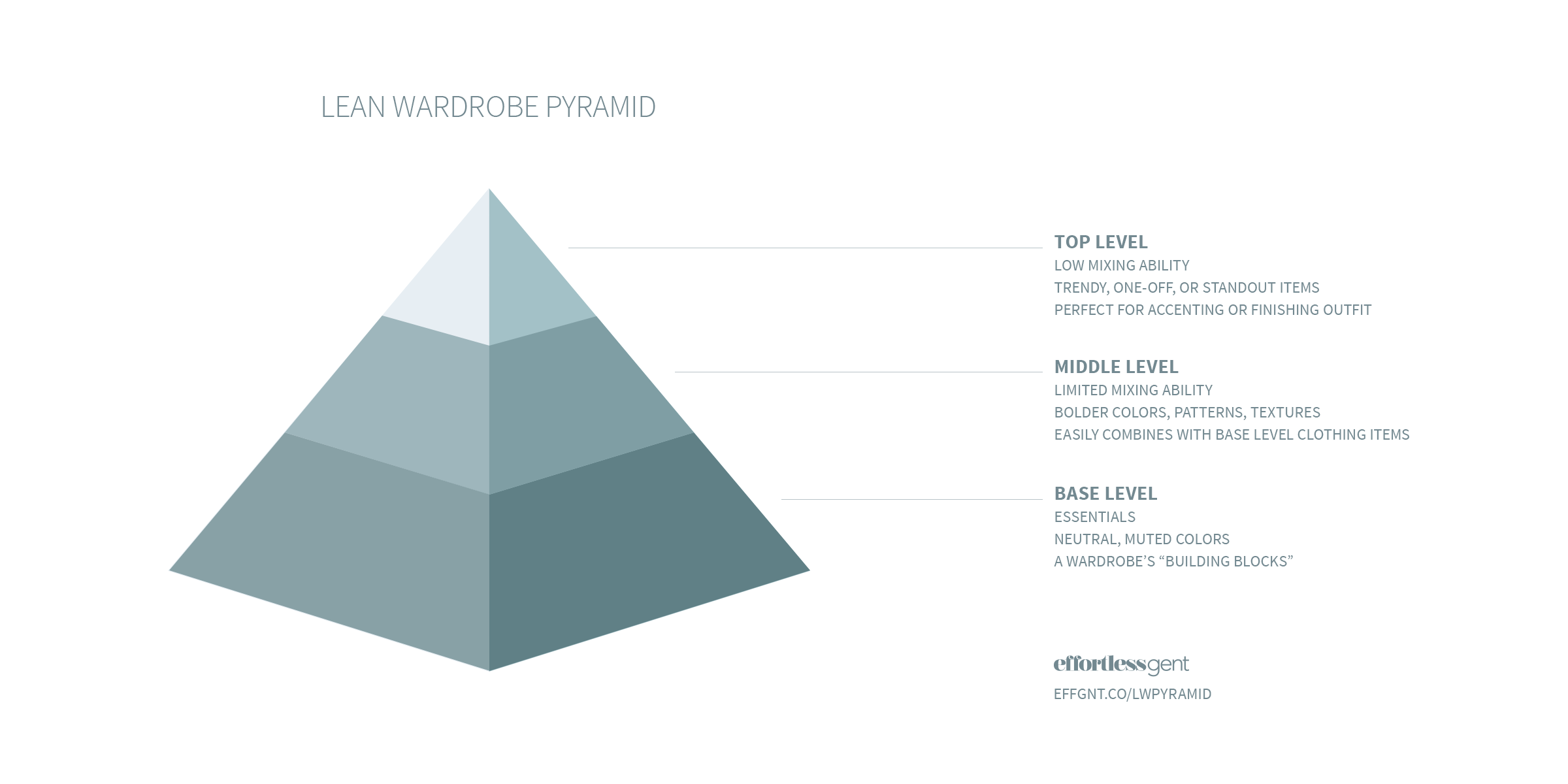When a man is building himself a minimalist wardrobe but still learning the ins and outs of dressing well and classifying casual outfits vs. formal outfits, buying new clothing or organizing what he’s got may seem like an insurmountable challenge.
He’s probably asking himself questions such as:
- Where do I begin?
- What’s most important?
- How can I even tell the difference?
My first inclination is to point him to the Lean Wardrobe philosophy, but even before he goes that far, I think he’d need a bit more background… a road map, if you will, so he knows where he’s going.
The Lean Wardrobe Pyramid: Visualizing The Perfect Men’s Minimalist Wardrobe
So, here’s my theory that should prove useful to the gent who’s still attempting to create the perfect men’s minimalist wardrobe. Let’s think of the Lean Wardrobe as a pyramid, split into three levels.

The bottom is your base. It comprises the building blocks of your wardrobe. All your essentials. Your basics, in both garment style and color.
This is where your navy suit is, your dark denim, your khaki chinos, your T-shirt, your blue Oxford cloth button down.
These are typically solid, muted, and / or neutral in color. They go with everything, and they play nicely with each other.
The middle level contains pieces that are limited in their ability to mix with others.
Think bolder patterns, textures, and colors. Your multi-colored plaid, a yellow
These things go well with your base-level items one-on-one, but not so easily with each other. It’s certainly possible, you’d just have to understand how to match and complement colors and textures well.
The top level contains all your trendy, one-off or standout items. Things you see other people wear and want to try, too.
These are items like a white fedora, purple bowties with sunglass print, suspenders, a bold blazer, an in-your-face pocket square.
Own fewer items the more you move up the pyramid
In keeping with the Lean Wardrobe theory, you want a majority of your closet to contain the base items, things that are interchangeable in style and color, because these pieces will go with everything no matter what other clothing you choose.
You should own the fewest top-level items, those unique (yet inflexible) pieces. They’re great to finish off or accent your base outfit, but shouldn’t comprise your whole wardrobe. Not only would that be impractical, but you limit yourself in terms of interchangeability with the rest of your clothing.
Clothing in your base level ≠ someone else’s
What’s trendy or outstanding to you (i.e. suspenders), may be part of someone else’s base level.
The ideal Lean Wardrobe is different for everyone, and completely dependent upon one’s situation, income, and surroundings.
Just keep that in mind when you’re building your wardrobe. Find out what’s important to you and what fits your lifestyle best, and roll with that.
The complete Lean, Minimalist Wardrobe is MORE than just essentials
Sure, a majority of it is your essentials, your base-level items. These clothes are your wardrobe’s building blocks, the starting point of all your outfits.
But a wardrobe built on essentials alone is kind of… boring.
You need mid-level items and top-level trendy accessories. You need to introduce color in your wardrobe other than navy, gray, khaki, and white.
You need to experiment with trends outside of your comfort zone, because who knows, you may discover something you originally thought too far outside your level of comfort is actually pretty awesome and looks great on you. That means you can incorporate it more regularly in your rotation.
Does that help?
Curious to know if this helps you visualize the Lean Wardrobe idea better. Also would love to know if you prefer these shorter, more succinct posts vs our longer-form writing.
Let’s chat in the comments below!
